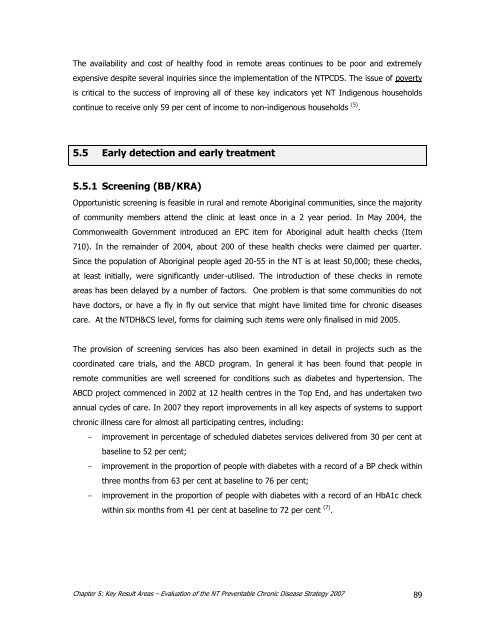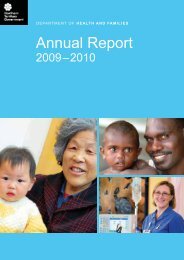PCD Strategy Evaluation 2007.pdf - NT Health Digital Library ...
PCD Strategy Evaluation 2007.pdf - NT Health Digital Library ...
PCD Strategy Evaluation 2007.pdf - NT Health Digital Library ...
Create successful ePaper yourself
Turn your PDF publications into a flip-book with our unique Google optimized e-Paper software.
The availability and cost of healthy food in remote areas continues to be poor and extremelyexpensive despite several inquiries since the implementation of the <strong>NT</strong><strong>PCD</strong>S. The issue of povertyis critical to the success of improving all of these key indicators yet <strong>NT</strong> Indigenous householdscontinue to receive only 59 per cent of income to non-indigenous households (5) .5.5 Early detection and early treatment5.5.1 Screening (BB/KRA)Opportunistic screening is feasible in rural and remote Aboriginal communities, since the majorityof community members attend the clinic at least once in a 2 year period. In May 2004, theCommonwealth Government introduced an EPC item for Aboriginal adult health checks (Item710). In the remainder of 2004, about 200 of these health checks were claimed per quarter.Since the population of Aboriginal people aged 20-55 in the <strong>NT</strong> is at least 50,000; these checks,at least initially, were significantly under-utilised. The introduction of these checks in remoteareas has been delayed by a number of factors. One problem is that some communities do nothave doctors, or have a fly in fly out service that might have limited time for chronic diseasescare. At the <strong>NT</strong>DH&CS level, forms for claiming such items were only finalised in mid 2005.The provision of screening services has also been examined in detail in projects such as thecoordinated care trials, and the ABCD program. In general it has been found that people inremote communities are well screened for conditions such as diabetes and hypertension. TheABCD project commenced in 2002 at 12 health centres in the Top End, and has undertaken twoannual cycles of care. In 2007 they report improvements in all key aspects of systems to supportchronic illness care for almost all participating centres, including:- improvement in percentage of scheduled diabetes services delivered from 30 per cent atbaseline to 52 per cent;- improvement in the proportion of people with diabetes with a record of a BP check withinthree months from 63 per cent at baseline to 76 per cent;- improvement in the proportion of people with diabetes with a record of an HbA1c checkwithin six months from 41 per cent at baseline to 72 per cent (7) .Chapter 5: Key Result Areas – <strong>Evaluation</strong> of the <strong>NT</strong> Preventable Chronic Disease <strong>Strategy</strong> 2007 89
















